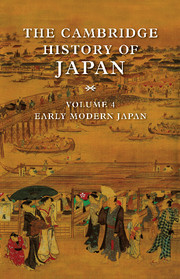Book contents
- Frontmatter
- 1 Introduction
- 2 The sixteenth-century unification
- 3 The social and economic consequences of unification
- 4 The bakuhan system
- 5 The han
- 6 The inseparable trinity: Japan's relations with China and Korea
- 7 Christianity and the daimyo
- 8 Thought and religion: 1550–1700
- 9 Politics in the eighteenth century
- 10 The village and agriculture during the Edo period
- 11 Commercial change and urban growth in early modern Japan
- 12 History and nature in eighteenth-century Tokugawa thought
- 13 Tokugawa society: material culture, standard of living, and life-styles
- 14 Popular culture
- Works Cited
- Index
- Provinces and regions of early modern Japan
- References
9 - Politics in the eighteenth century
Published online by Cambridge University Press: 28 March 2008
- Frontmatter
- 1 Introduction
- 2 The sixteenth-century unification
- 3 The social and economic consequences of unification
- 4 The bakuhan system
- 5 The han
- 6 The inseparable trinity: Japan's relations with China and Korea
- 7 Christianity and the daimyo
- 8 Thought and religion: 1550–1700
- 9 Politics in the eighteenth century
- 10 The village and agriculture during the Edo period
- 11 Commercial change and urban growth in early modern Japan
- 12 History and nature in eighteenth-century Tokugawa thought
- 13 Tokugawa society: material culture, standard of living, and life-styles
- 14 Popular culture
- Works Cited
- Index
- Provinces and regions of early modern Japan
- References
Summary
By the middle of the seventeenth century, the government of Japan in many important respects had assumed the shape it was thereafter to maintain for the next two hundred years. The emperor, nominal head of state, was kept in Kyoto, isolated and virtually powerless. In Edo, the administrative center of the country, was the bakufu, a government staffed by a large group of samurai officials. Already they were at work producing a voluminous and dense body of statutes, precedents, and procedural instructions to cope with the increasingly complex society over which they presided. The sixty-eight provinces were divided among 250 feudal lords, or daimyo, all to some extent autonomous but all having sworn – with a greater or lesser degree of sincerity – undying loyalty to the Tokugawa shogun. None of them had found the first fifty years of the new regime particularly easy. Some had been plucked abruptly from the Tokugawa vassal band to assume independent responsibilities for the first time; others, once Tokugawa equals and even rivals, had suffered in various ways, their domains now surrounded by Tokugawa watchdogs or shifted from favorable locations to areas more distant or less prosperous. Even so, they were the lucky ones – luckier by far than those 175 of their peers who lost all or part of their domains during the first half of the seventeenth century.
Once the first fifty years had passed, however, there were undeniable signs that having attained a certain measure of security, the Tokugawa revolution in government was coming to a halt.
Keywords
- Type
- Chapter
- Information
- The Cambridge History of Japan , pp. 425 - 477Publisher: Cambridge University PressPrint publication year: 1991
References
- 3
- Cited by

